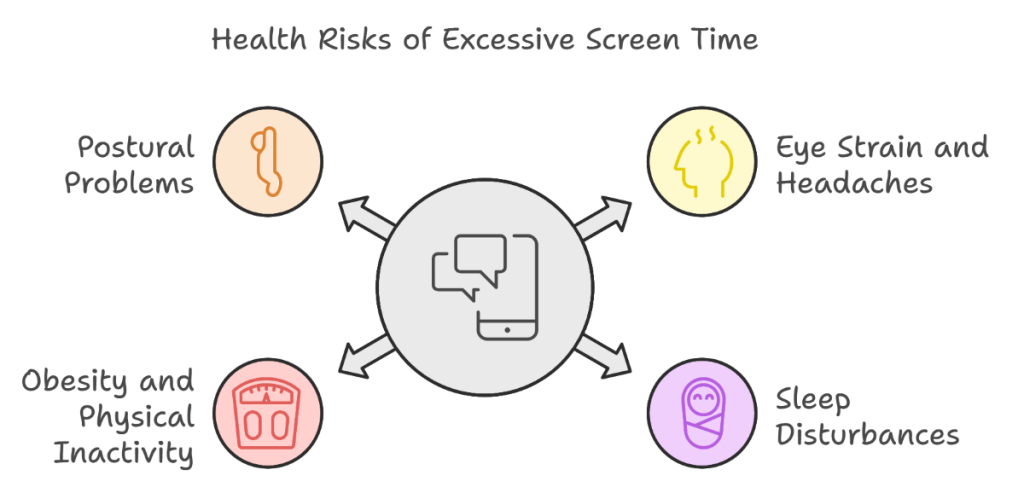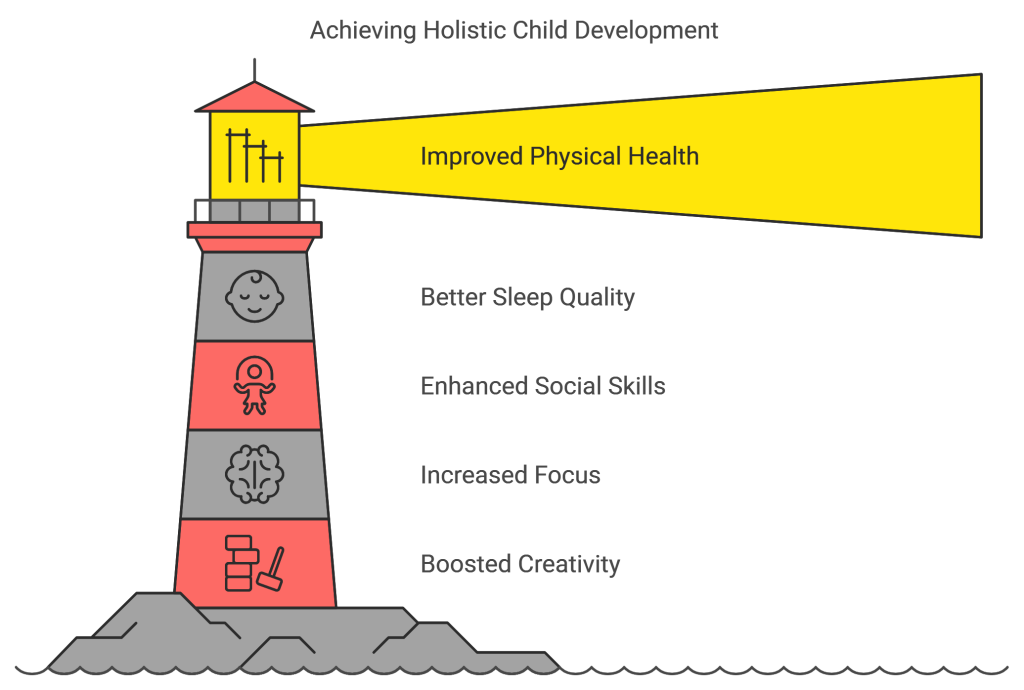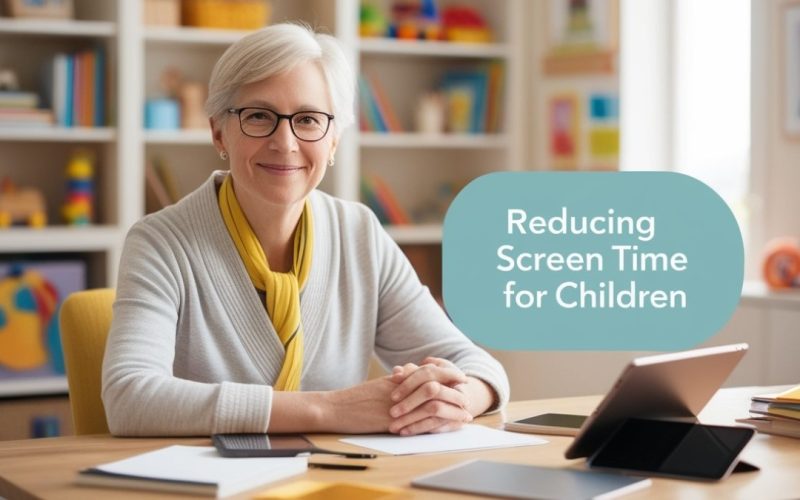The rise of digital technology has significantly transformed daily life, especially for children. The COVID-19 pandemic further exacerbated this shift, making screens an integral part of education, entertainment, and social interaction, which given rise to need to reduce screen time for children for their better growth.
While technology offers numerous benefits, excessive screen time can negatively impact children’s physical, emotional, and developmental well-being. As parents and guardians, understanding these risks and taking proactive steps to manage & reduce screen time is essential for fostering a healthy lifestyle for children.
In this comprehensive guide, we will delve into the various consequences of excessive screen time, the importance of setting boundaries, and actionable strategies for reducing screen time for children.
Backed by research, WHO, NHLBI and expert recommendations, this article aims to provide a holistic approach to managing children’s screen time effectively while promoting a balanced and healthy lifestyle.
The Impact of Excessive Screen Time on Children’s Health and Development

Health Risks of Too Much Screen Time
Excessive screen time can lead to various physical health issues that should not be overlooked. Prolonged exposure to screens affects children’s bodies in several ways, such as:
1. Eye Strain and Headaches: Staring at screens for extended periods can cause digital eye strain, also known as “computer vision syndrome.” Symptoms include dry eyes, blurred vision, and headaches, which are increasingly common among children who spend a lot of time on digital devices.
2. Sleep Disturbances: Blue light emitted by screens can disrupt the production of melatonin, the hormone responsible for regulating sleep. Studies have shown that children exposed to screens, especially before bedtime, experience difficulties falling asleep, leading to poor sleep quality and fatigue during the day.
3. Obesity and Physical Inactivity: Sitting for long periods while using screens reduces physical activity, contributing to weight gain. Obesity in children is linked to a sedentary lifestyle, which has become more prevalent as screen time increases.
A lack of physical activity not only affects weight but also leads to weak muscles and poor cardiovascular health.
4. Postural Problems: Slouching or improper posture while using digital devices can result in back, neck, and shoulder pain which can further lead to Cervical. Poor posture in childhood may lead to long-term musculoskeletal issues as the child grows.
Developmental Concerns Linked to Screen Time
While physical health concerns are significant, the developmental impact of excessive screen use can also have profound consequences:
1. Delayed Social Skills Development: Over-reliance on screens for entertainment and communication can hinder the development of essential social skills in children. Social interactions, both in-person and online, are vital for developing emotional intelligence, empathy, and the ability to navigate social situations.
2. Reduced Attention Span: Research has found that children who spend excessive time on screens, especially with fast-paced content, can experience a decline in their attention span. This can lead to difficulties in focusing on tasks that require sustained concentration, such as schoolwork or reading.
3. Impact on Creativity and Imagination: Screen-based entertainment often offers structured content, which limits children’s opportunities to engage in imaginative play. Free play, without screens, fosters creativity, problem-solving skills, and cognitive development.
4. Decreased Physical Activity: Screen time often replaces physical activities, leading to a sedentary lifestyle. Physical play is crucial for children’s motor skills development, coordination, and overall physical health. WHO, in this report, also recommends that more time spent in physical activity by kids, helps them to grow properly.
The Role of Parents in Managing Screen Time
Parents play a vital role in helping children maintain a healthy relationship with screens. By setting clear boundaries and encouraging alternative activities, parents can ensure that screen time does not dominate their child’s life.

Setting Age-Appropriate Screen Time Limits
Setting appropriate screen time limits based on a child’s age is critical for ensuring healthy development. The American Academy of Pediatrics (AAP) offers specific guidelines for screen time based on age groups:
1. Children Under 18 Months: Avoid Screens, Except for Video Calls
For infants and toddlers under 18 months, screen time should be limited to video calls with family members or caregivers. Early childhood is a crucial time for brain development, and interactions with caregivers and the surrounding environment are essential for learning.
2. Children Aged 2-5 Years: Limit to One Hour of High-Quality Educational Programming
For preschool-aged children, screen time should be limited to no more than one hour per day of high-quality educational content. Programs that encourage interactive learning, such as language development or problem-solving, are more beneficial than passive viewing.
3. Children Aged 6 Years and Older: Establish Consistent Rules for Screen Use
Once children reach school age, parents should establish consistent rules and limits for screen use. While the AAP does not provide a specific daily screen time limit for older children, it is essential to balance screen time with other activities, such as homework, physical play, and family time.
Creating a family media plan that includes specific screen-free times and zones can help maintain this balance.
Effective Strategies to Reduce Screen Time for Children
Reducing screen time requires a multi-faceted approach that involves setting boundaries, modeling healthy behaviors, and encouraging alternative activities.

Here are some effective strategies that parents can implement to manage or reduce screen time of their children:
1. Modeling Healthy Screen Habits
Children often mimic their parents’ behavior, so it’s essential for adults to model healthy screen habits. If parents are constantly on their devices, children will perceive screen use as normal and acceptable.
By limiting personal screen time and engaging in non-digital activities, parents set a positive example for their children to follow.
2. Creating Technology-Free Zones at Home
Designating specific areas of the home as “technology-free zones” can help create an environment that promotes screen-free activities.
For example, the dining room, bedrooms, or family rooms can be designated as spaces where no screens are allowed. This encourages more face-to-face interaction, creative play, and relaxation without the distraction of digital devices.
3. Encouraging Alternative Activities
One of the most effective ways to reduce screen time is by offering children engaging alternatives. Here are a few options:
Outdoor Play: Encourage children to spend time outdoors, whether it’s playing sports, riding a bike, or simply exploring nature. Outdoor play promotes physical activity and helps children develop motor skills.
Board Games and Puzzles: These activities provide entertainment and challenge children’s problem-solving skills, while also offering opportunities for family bonding.
Arts and Crafts: Creative activities such as drawing, painting, or building models stimulate the imagination and allow children to express themselves without screens.
Structured Independent Play: Providing children with structured activities, such as building blocks or toy sets, fosters independent play, critical thinking, and creativity.
4. Implementing Unplugged Hours
Designating specific times of the day as “unplugged hours” can significantly reduce screen time and encourage family bonding. For example, families can agree to have screen-free meals, where everyone focuses on enjoying the food and conversation without the distraction of phones, tablets, or TVs.
Other unplugged times could include after school or before bedtime, allowing children to unwind and relax without screens.
5. Setting Clear Rules and Schedules
Creating a daily routine that includes limited screen time can help children develop healthy habits. Involving children in the process of setting screen time rules gives them a sense of ownership and responsibility, making them more likely to follow the guidelines.
For example, parents and children can agree on when screen time is allowed (such as after homework or chores are completed) and when it is restricted (during meals or family activities).
6. Using Technology Wisely
While limiting or reducing screen time is important, it’s equally crucial to use technology wisely when it is allowed. Here are a few tips for making the most of screen time:
Parental Controls and Monitoring Apps: Parents can use apps and built-in parental controls to monitor and limit screen time. These tools allow parents to set time limits, block inappropriate content, and track how much time children spend on different apps or websites.
Prioritizing Educational Content: When screen time is permitted, prioritize high-quality educational content that enhances learning and development. Look for programs or games that encourage creativity, problem-solving, and critical thinking.
Communicating with Children About Screen Time
Effective communication is key to managing screen time successfully. Parents should openly discuss the reasons behind screen time limits and involve children in the decision-making process.
1. Explaining the Importance of Screen Time Limits
Children are more likely to follow screen time rules if they understand why those rules exist. Parents should explain how excessive screen time can affect their health, sleep, and ability to focus.
Framing the conversation around the benefits of balanced screen use, such as more time for play, learning, and family activities, can help children see the positive side of limiting their screen use.
2. Encouraging Open Dialogue and Feedback
Encouraging children to share their thoughts and feelings about screen time rules can make the process more collaborative. When children feel heard, they are more likely to respect the boundaries set by their parents.
Parents should listen to their child’s feedback and make adjustments to the rules if necessary, while still maintaining clear and consistent limits.
The Benefits of Reducing Screen Time

Reducing screen time offers numerous benefits for children’s physical, emotional, and social development. WHO also recommends that play more and sit less, to grow more. Here are a few of the key advantages:
1. Improved Physical Health
Limiting screen time encourages children to engage in physical activities, such as playing outside, participating in sports, or simply moving around more during the day. This helps prevent weight gain, strengthens muscles, and improves overall fitness.
2. Better Sleep Quality
By reducing screen time, especially before bedtime, children can experience improved sleep quality. Limiting exposure to blue light and creating a calming bedtime routine without screens can help children fall asleep more easily and wake up feeling rested.
3. Enhanced Social and Emotional Skills
Reducing screen time allows children to spend more time interacting with family members and peers in real-life settings
. These interactions help children develop essential social and emotional skills, such as empathy, communication, and conflict resolution.
4. Increased Focus and Attention
Children who spend less time on screens tend to have better attention spans and are more capable of focusing on tasks that require sustained concentration. This can lead to improved academic performance and greater success in school-related activities.
5. Boosted Creativity and Imagination
Engaging in screen-free play stimulates children’s imagination and creativity. Activities like building, drawing, or storytelling allow children to express themselves and explore new ideas without the constraints of structured digital content.
The Final Words
In today’s technology-driven world, managing & reduce screen time for children is a challenge, but it’s an essential part of fostering a healthy lifestyle. By setting clear and consistent screen time limits, modeling positive behavior, and encouraging a wide range of alternative activities, parents can help their children develop a balanced relationship with technology.
Open communication, patience, and flexibility are key to successfully reducing screen time while supporting children’s overall well-being.





